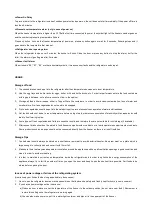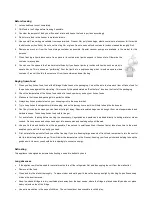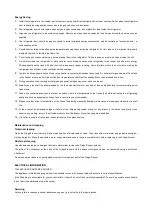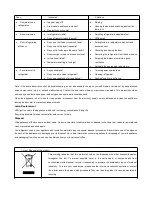
Energy Saving
1.
Install the refrigerator in the coolest part of the room, away from direct sunlight and from heat sources. Do not place the refrigerator
next to heat-producing appliances such as a range hood, oven or dishwasher.
2.
The refrigerator door should remain open only as long as necessary; do not place hot food inside the refrigerator.
3.
Organize the refrigerator to reduce door openings. Remove as many items as needed at one time and close the door as soon as
possible.
4.
The refrigerator door should be properly closed to avoid increased energy consumption, and the formation of excess ice and / or
condensation inside.
5.
Constantly circulating cold air keeps the temperature homogenous inside the refrigerator. For this reason, it is important to properly
distribute the food, to facilitate the flow of air.
6.
Cover foods and wipe containers dry before placing them in the refrigerator. This cuts down on moisture build-up inside the unit.
7.
Do not overcrowd the refrigerator or block cold air vents. Doing so causes the refrigerator to run longer and use more energy.
Shelves should not be lined with aluminum foil, wax paper or paper toweling. Liners interfere with cold air circulation, making the
refrigerator less efficient, which could cause food spoilage.
8.
Food to be frozen should not be stored in the freezer in contact with already frozen food. Do not store large amounts of fresh food
in the freezer at once as it will reduce the inner temperature and will put the already frozen food preservation in risk.
9.
During your absences, remember that prolonged power outages may occur while you are out.
10.
Always keep the shelf life recommended by the food manufacturers for any kind of food and particularly for commercially quick-
frozen food.
11.
Take all necessary precautions to prevent an undue rise in the temperature of the frozen food while defrosting the refrigerating
appliance, such as wrapping the frozen food in several layers of newspaper.
12.
Please note that a rise in temperature of the frozen food during manual defrosting, maintenance or cleaning could shorten its shelf
life.
13.
In the event of an extended outage or failure of the refrigerating system check for any impact in the frozen food state. If you
observe any melting, remove the affected products from the freezer. Never freeze again melted food.
14.
It is better to wrap the frozen food in several layers on the glass shelves.
Maintenance and cleaning
1.Internal cleaning
Clean the Fridge/Freezer internally with a weak solution of bicarbonate of soda. Then rinse with warm water using a damp sponge or
cloth and wipe dry. Wash the baskets in warm soapy water and ensure they are completely dry before replacing in the Fridge/Freezer.
2.External cleaning
Use standard non-abrasive detergent diluted in warm water to clean the Fridge/Freezer exterior.
The grille of the condenser at the back of the Fridge/Freezer and the adjacent components can be vacuumed using a soft brush
attachment.
Do not use harsh cleaners, scouring pads or solvents to clean any part of the Fridge/Freezer
ELECTRICAL INFORMATION
THIS APPLIANCE MUST BE EARTHED.
This appliance is fitted with a plug which will be suitable for use in all houses fitted with sockets to current specifications.
If the fitted plug is not suitable for your socket outlets, it should be cut off and carefully disposed of. To avoid a possible shock hazard,
do not insert the discarded plug into a socket.
Servicing
Not every failure requires technical assistance; you can try to solve the following situations:
Summary of Contents for SC 201B
Page 1: ...0 5 25 75 95 100 ...
Page 11: ...0 5 25 75 95 100 ...
















